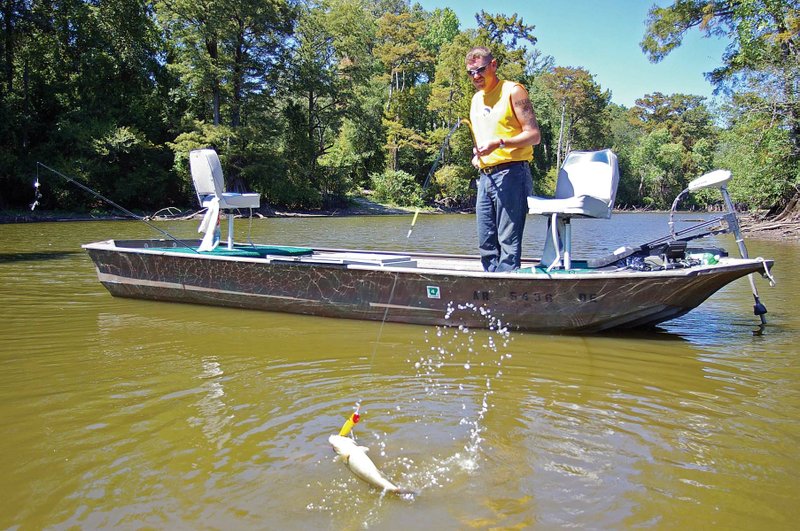Have you ever thought how different fishing was in past centuries? The modern tackle we use is very different from — and much better than — the simple tools used by anglers prior to the 20th century. Back “in the old days,” catching bass was much more difficult.
To compensate for poor-quality, short-range tackle, early anglers developed innovative fishing techniques designed to draw up-close strikes. One such technique — doodlesocking — is rarely tried by today’s bass anglers but is making a comeback in some areas, including Arkansas. With a bit of improvisation, you can adapt modern tackle for use with this fun technique, and you should find the results pleasantly surprising.
One of my uncles was a doodlesocker extraordinaire. For this, he employed a stout cane pole, which had heavy Dacron line run along its entire length, from butt to tip, and secured at regular intervals with strips of electrical tape. A 12- to 24-inch piece of line extended beyond the pole’s tip. To this was tied a big topwater plug.
While I sat on the front seat of the cypress johnboat and sculled him about, Uncle Guy sputtered that lure around every piece of cover we passed. Then, without warning, the water would boil like someone flushed a toilet. Bass on! My uncle would back the pole in and hoist another largemouth into the boat. I watched as he caught dozens of huge largemouths that attacked his plugs with frenzied charges.
When doodlesocking was at the peak of its popularity, cane poles were used, but modern practitioners prefer 12- to 16-foot fiberglass or graphite/composite jigging poles or fly-fishing rods. Dacron was the line of choice for old-timers, but doodlesockers now use braided lines. The line should be stout, 30-pound-test minimum, and 50- to 80-pound-test is even better. To avoid losing fish if the pole’s tip breaks, run line along the whole length of the pole, and tape it at several points. Leave only a foot or 2 beyond the tip, and place a snap swivel at line’s end to lessen line twist.
I suppose any topwater lure could be used, but prop baits seem especially effective. A special favorite in decades past was the big Heddon Dowagiac, a model with propellers fore and aft, which was armed with five sets of treble hooks. In fact, this bassing technique once was called “dowjacking,” a name that originated from the use of this lure. Among the best doodlesocking lures available today are the Smithwick Devil’s Horse, Cordell’s Boy Howdy, Luhr-Jensen’s Nip-I-Diddee, Heddon’s Torpedo and Booyah’s Pond Magic buzzbait.
As the doodlesocker moves along the shore, the lure is worked back and forth very quickly with short repetitive sweeps of the pole. This is hurly-burly stuff. The objective is to make as much noise as you can while fishing the plug in a circular or figure-eight pattern in small openings.
You should thoroughly work the lure near all cover adjacent to the shore in shallow water, as this provides a sure advantage. Anglers who cast and retrieve may miss fish lying between targets, but the doodlesocker can cover an entire shoreline. The long pole allows you to lift your lure and put it in pockets that might otherwise be missed. You can fish in the center of logjams, under low-hanging boat docks and behind stumps and bushes. Few places exist where a doodlesocker can’t swim a topwater plug.
Doodlesocking’s effectiveness is tied to the fact that the lure remains longer in the fish’s strike zone than a lure being cast and retrieved. Bass see and hear the lure coming down the bank and wait in ambush. When fish aren’t feeding aggressively, an angler can slow the pole’s rhythm and make the lure look so tempting, a bass will strike even if it’s not hungry.
It’s exciting when a bass gets a bellyful of your doodlesocking plug, making bubble trails across its ceiling. Strikes are violent. Sometimes a bass hits so hard it throws water in your face.
If a fish misses your lure, no problem. Drag the enticement back over the fish, and hold tight. Lunkers may hit several times before you hook up.
Shad or big minnows can also be used for doodlesocking. Tie on a 3/0 hook instead of the topwater plug, add a small sinker to get the bait under the water, and then run the hook down through the bait’s mouth and out its side. Then doodlesock the bait around logs, stumps, brush piles and other cover with a swimming motion.
All black bass — largemouths, spotted bass and smallmouths — can be caught by doodlesocking. And as this technique comes back into vogue, more and more Arkansas anglers are learning quickly that doodlesocking is a hard-to-beat lunker bass tactic anytime fish are in shallow water.
Catching bass using this old-fashioned technique takes a bit of learning, but don’t let that discourage you. It may seem out of date for catching today’s bass, but doodlesocking is just as relevant and effective now as it was in centuries past.
